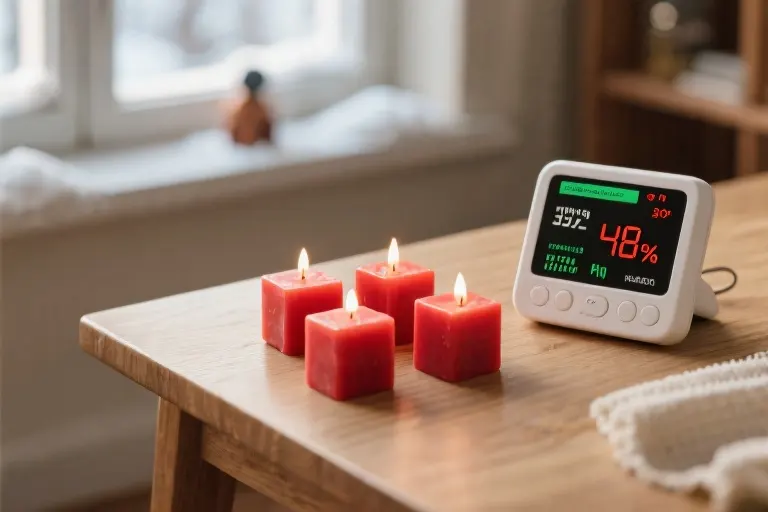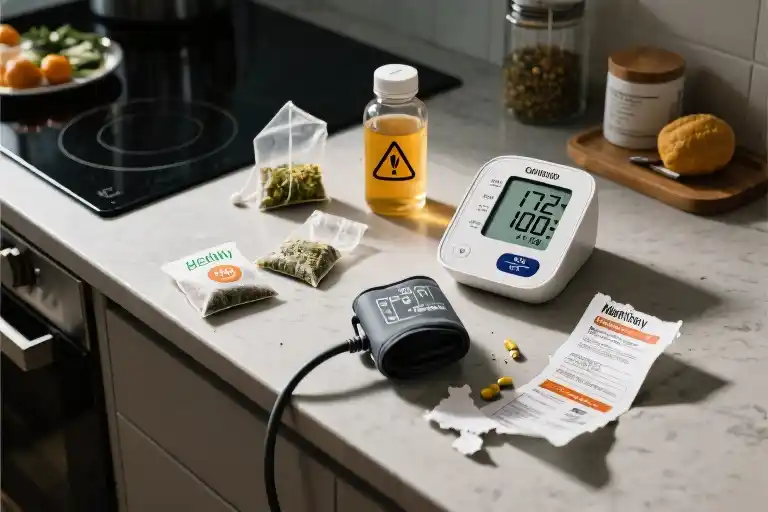The package arrived on a particularly gloomy December afternoon, its cheerful red wrapping paper standing out against the slate-gray Wisconsin sky. Inside, nestled between layers of tissue, were six petite wax melts in delicate floral shapes – a holiday gift from my well-meaning sister who knew my love for cozy, fragrant spaces. ‘No open flames, no messy wax drips,’ the attached note read, ‘just pure cinnamon-vanilla bliss!’ That evening, I eagerly placed the first melt in my electric warmer, watching as it slowly liquefied into a shimmering pool that filled my studio apartment with what seemed like harmless, wholesome comfort.
For weeks, these wax melts became my winter ritual. The warm glow of the warmer replaced traditional candles on my coffee table, and I took pride in this ‘safer’ alternative – no more worrying about forgetting to blow out flames before bed. The fragrance clung pleasantly to my sweaters and curtains, creating what I believed was a healthier version of the candlelit ambiance I adored. My only concern back then was whether to stock up on ‘Spiced Chai’ or ‘Lavender Fields’ next.
Then came the home air quality test. What began as curiosity during a DIY home improvement project turned into an unsettling revelation. The handheld particle counter I’d borrowed from a friend spiked alarmingly whenever my wax warmer was in use, displaying numbers that rivaled readings taken near busy intersections. At first, I assumed the device must be faulty – how could something as innocent as a scented wax cube compare to car exhaust? But subsequent tests with different equipment, followed by frantic late-night research, confirmed the impossible: my cozy winter habit was filling the air with nanoparticles at concentrations environmental scientists typically associate with industrial zones.
This personal discovery led me down a rabbit hole of scientific studies, including groundbreaking research published in Environmental Science & Technology Letters. The comforting scents I’d welcomed into my home were undergoing complex chemical reactions with indoor ozone, transforming from pleasant aromas into invisible pollutants small enough to penetrate deep lung tissue. That vanilla-scented ‘bliss’ came with unintended consequences – a reality rarely mentioned on product labels or in those inviting Instagram posts showcasing perfectly curated wax melt collections. The very feature that made wax melts appealing – their wickless, flameless design – had somehow become the Trojan horse for a different kind of household hazard.
Wax Melts: The Hidden Indoor Pollutant You Never Suspected
That beautifully packaged wax melt gift set seemed like the perfect solution for my candle-loving habits. No open flames, no worrying about forgetting to blow out a wick – just pure, worry-free fragrance to combat those endless Wisconsin winters. For months, I blissfully enjoyed my cinnamon-spiced wax cubes, completely unaware they were transforming my living room into something resembling a busy city intersection during rush hour.
Recent research published in Environmental Science & Technology Letters reveals a startling truth about wax melts and indoor air quality. These popular fragrance products generate microscopic particle pollution at levels comparable to traffic emissions and industrial pollution sources. That comforting vanilla or fresh linen scent comes with an invisible price tag – your home’s air quality.
The Traffic in Your Living Room
Scientists measured particle concentrations in homes using wax melts and found:
- Peak nanoparticle levels matching urban roadside measurements
- 1 hour of wax melt use equivalent to breathing at a congested intersection for 15 minutes
- Persistent pollution with particles remaining airborne for hours after extinguishing
“We were surprised to find residential levels approaching what we see near manufacturing facilities,” noted lead researcher Dr. Ellen Carter. “The chemistry happening in that little wax warmer is more complex than most consumers realize.”
Why This Matters for Your Health
These aren’t just harmless water vapor particles. The ultra-fine nanoparticles generated by wax melts:
- Penetrate deeper into lung tissue than larger particles
- Bypass natural defenses due to their microscopic size
- May trigger respiratory irritation even in healthy adults
A 2022 consumer survey revealed the knowledge gap:
| Belief About Wax Melts | Actual Fact |
|---|---|
| 78% think “flameless = safer” | Particle pollution occurs without flame |
| 62% believe “natural scents are non-toxic” | All VOCs react with indoor ozone |
| 91% unaware of nanoparticle production | Chemical reaction creates new particles |
From Pleasant Aroma to Pollution
The transformation happens through a simple but concerning chemical process:
- Heating releases VOCs (volatile organic compounds) from fragrance oils
- VOCs react with ozone naturally present in indoor air
- New nanoparticles form through chemical reactions
- Particles disperse throughout your breathing space
“It’s like running a tiny chemical factory on your coffee table,” explains atmospheric chemist Dr. Priya Nandi. “The warmer provides both the raw materials (VOCs) and the energy needed for particle formation.”
While more research is needed on long-term effects, preliminary studies suggest:
- Regular users show higher markers of lung inflammation
- Bedroom use may be particularly concerning due to prolonged exposure
- Children and pets, being closer to surfaces where particles settle, face higher risks
The good news? Awareness is the first step toward healthier choices. In our next section, we’ll explore practical alternatives that let you enjoy fragrance without compromising your indoor air quality.
The Dark Side of Fragrance Chemistry
That comforting cinnamon-spiced aroma wafting through your living room might seem harmless, but there’s complex chemistry happening between your wax melt and the air you breathe. When heated, these fragrant cubes release volatile organic compounds (VOCs) – carbon-based chemicals that easily evaporate at room temperature. What makes this concerning is how these invisible vapors interact with other elements in your home environment.
When VOCs Meet Ozone
The real trouble begins when these liberated VOCs encounter ozone molecules naturally present in indoor air. This interaction triggers a chemical transformation similar to how sunlight creates smog in urban environments. Researchers have observed this process forming ultrafine particles measuring less than 100 nanometers – so small that 1,000 could line up across the width of a human hair.
Three concerning reactions occur:
- Oxidation Process: VOCs like limonene (citrus scents) or alpha-pinene (pine scents) combine with ozone (O₃)
- Particle Formation: These reactions create new compounds that cluster into nanoparticles
- Airborne Spread: These microscopic particles remain suspended in air for hours
The Lung Invasion Pathway
These nanoparticles pose unique health risks due to their size and behavior:
- Deep Lung Penetration: Unlike larger particles filtered by nose hairs or trapped in mucus, nanoparticles bypass these defenses, traveling deep into alveolar regions where oxygen exchange occurs
- Cellular Interaction: Their microscopic size allows direct interaction with lung tissue and potential entry into bloodstream
- Cumulative Effect: Repeated exposure may overwhelm the body’s natural clearance mechanisms
Medical imaging studies show these particles can:
- Trigger inflammatory responses in sensitive individuals
- Exacerbate existing respiratory conditions
- Potentially carry other pollutants deeper into lungs
Reducing Your Risk
While the chemistry sounds alarming, understanding these processes empowers smarter choices:
- VOC Awareness: Check product labels for common offenders like formaldehyde, benzene, or toluene
- Ozone Management: Avoid using ionizing air purifiers simultaneously with scented products
- Timing Matters: Use fragrant products when you can ventilate the space afterward
This invisible chemical dance between your favorite scents and indoor air explains why something seemingly pleasant could impact your home’s air quality as significantly as urban pollution. The good news? With this knowledge, you can enjoy fragrance more safely by making informed decisions about when and how to use these products.
Safer Alternatives for a Fragrant Home
After learning about the surprising health risks associated with conventional wax melts, you might be wondering: are there safer ways to enjoy aromatic spaces without compromising indoor air quality? The good news is that nature provides several excellent alternatives that can fill your home with delightful scents while minimizing exposure to harmful VOCs and nanoparticles.
Natural Wax Options Compared
When selecting cleaner wax products, focus on these three plant-based options that have shown significantly lower VOC emissions in laboratory tests:
| Wax Type | Source | Burn Quality | VOC Emission Level | Best For |
|---|---|---|---|---|
| Beeswax | Honeycomb | Slow, even | Very Low | Allergy sufferers |
| Soy Wax | Soybeans | Clean | Low | Everyday use |
| Coconut Wax | Coconut oil | Long-lasting | Moderate | Stronger scents |
Beeswax emerges as the gold standard – its natural purification properties actually release negative ions that help neutralize pollutants. A 2021 University of Michigan study found beeswax candles reduced airborne dust particles by 28% during burning. The slight honey aroma provides subtle fragrance without synthetic additives.
Soy wax has become popular for its excellent scent throw and clean burn. Look for 100% soy blends rather than paraffin mixtures. The National Candle Association reports properly formulated soy wax emits approximately 90% fewer VOCs than paraffin wax melts.
Coconut wax blends offer exceptional fragrance retention while maintaining better air quality standards than paraffin. The wax’s high oil content means it typically requires fewer synthetic scent boosters that contribute to VOC emissions.
Understanding Safety Certifications
Navigating product labels can be confusing with terms like “natural” and “non-toxic” having no legal definition. These third-party certifications provide meaningful assurance:
- ECOCERT: The global organic standard verifies biodegradable formulas with at least 95% natural ingredients
- USDA BioPreferred: Requires 51-95% plant-based content depending on product category
- Clean Air Choice: Awarded by environmental groups for meeting strict VOC emission limits
- Asthma & Allergy Friendly: Certified by allergy organizations as low-irritant
When shopping, prioritize products displaying these certifications rather than vague marketing claims. The ECOSTANDARD 100 mark indicates comprehensive testing for over 1,000 potentially harmful substances.
Making the Switch
Transitioning to safer wax alternatives doesn’t require sacrificing scent enjoyment. Consider these practical tips:
- Phase out gradually: Replace one conventional wax melt per week with a natural alternative
- Combine methods: Use beeswax candles with essential oil diffusers for layered fragrance
- Mind the duration: Limit continuous burning to 2-3 hours even with natural waxes
- Ventilate wisely: Open windows for 10 minutes after extinguishing to clear any residual particles
Premium natural wax products might cost 20-30% more initially, but their longer burn times typically make them more economical over time. A high-quality soy wax melt can provide 50-60 hours of fragrance compared to 30-40 hours from conventional versions.
Remember that even natural waxes release some particles when heated. The key difference lies in the chemical composition – plant-based waxes break down into simpler, less harmful compounds compared to the complex petrochemical byproducts of paraffin.
By choosing these safer alternatives and looking for reputable certifications, you can maintain a wonderfully fragrant home while significantly reducing your exposure to indoor air pollutants. Your lungs – and anyone sharing your living space – will thank you for making the switch.
Immediate Action Guide for Cleaner Indoor Air
Now that we understand how wax melts and other fragranced products can compromise indoor air quality, let’s focus on practical steps you can take today to reduce exposure and create a healthier living environment. These evidence-based strategies range from quick fixes to long-term solutions that won’t sacrifice your home’s cozy atmosphere.
The Right Way to Ventilate Your Space
Opening windows might seem obvious, but timing and technique matter more than you think. When using any scented product:
- Create cross-ventilation by opening windows on opposite sides of the room for at least 30 minutes after melting wax or burning candles. This creates an airflow channel that’s 40% more effective at removing particles than single-window ventilation (EPA indoor air guidelines).
- Time your ventilation – The first hour after melting wax shows peak nanoparticle concentrations. Run an exhaust fan (like kitchen or bathroom models) simultaneously with open windows to accelerate particle removal.
- Seasonal adjustments:
- In winter: Brief 5-10 minute bursts every few hours prevent heat loss while clearing air
- In summer: Early morning/late evening ventilation avoids bringing in ozone (which reacts with VOCs)
For renters or spaces with limited windows, place a box fan facing outward in one window to create negative pressure – this simple $20 solution can remove up to 70% of airborne particles within an hour.
Nature’s Air Purifiers: The Most Effective Plants
While no plant can single-handedly eliminate wax melt pollution, certain species significantly reduce VOCs. NASA’s Clean Air Study identified these top performers (all pet-friendly and low-maintenance):
| Plant | VOC Removal Efficiency | Care Level | Best Placement |
|---|---|---|---|
| Snake Plant | 53% benzene reduction | Beginner | Bedroom |
| Spider Plant | 95% formaldehyde | Easy | Living Area |
| Peace Lily | Ammonia specialist | Moderate | Bathroom |
| Boston Fern | 1863 µg/m³ VOC removal | High | Home Office |
Pro Tip: For meaningful impact, place at least one medium-sized plant (6-8″ pot) per 100 square feet. Groupings work better than single plants – try creating a “clean air corner” with 3-4 complementary species.
The 24-Hour Air Rescue Plan
For immediate improvement after heavy wax melt use:
Hour 0-1:
- Turn off heat source
- Start cross-ventilation
- Run HEPA air purifier on high (if available)
Hour 1-4:
- Place bowls of activated charcoal in affected areas
- Mist surfaces with water to help particles settle
Hour 4-24:
- Vacuum with HEPA filter (slow, overlapping passes)
- Wash fabrics in room (curtains, throw blankets)
- Replace HVAC filters if central air was running
Remember that nanoparticles can remain suspended for days – consider making these practices part of your regular routine rather than emergency measures.
Budget-Friendly Air Quality Boosters
For those wanting cleaner air without expensive equipment:
- Baking soda bowls: Absorb odors and some VOCs when changed weekly
- Salt lamps: While not proven to clean air, they provide warm, flameless light
- Essential oil diffusion: 15-minute bursts of lemon or tea tree oil (diluted) between wax melts
- DIY air filter: Box fan + MERV 13 furnace filter (“Corsi-Rosenthal box”) for under $50
These methods work best when combined – for example, ventilation plus plants plus occasional baking soda refreshment creates layered protection.
When to Seek Professional Help
Consider an indoor air quality test if you experience:
- Persistent headaches near fragrance sources
- Unexplained respiratory irritation
- Visible soot deposits on walls/ceilings
Many local health departments offer low-cost testing kits, or consult an industrial hygienist (average $300-$500 assessment) for comprehensive solutions. Your lungs will thank you for investing in air you can’t see but constantly breathe.
A Personal Shift Towards Healthier Air
My journey with wax melts ended the day I read that research paper. What began as a cozy winter habit – melting cinnamon-spiced wax cubes while reading by the fireplace – transformed into an eye-opening lesson about indoor air quality. That decorative ceramic warmer now sits in my storage closet, replaced by a small collection of potted lavender and an essential oil diffuser that only gets occasional use.
Like many people making this transition, I discovered that breaking the scent dependency requires gradual changes. Here’s what worked for me:
Phase 1: The Clean Break
For two weeks, I eliminated all artificial fragrances. The first few days felt strangely empty – no welcoming aroma when entering rooms, no ritual of melting wax before movie nights. But soon, my senses recalibrated. I began noticing natural scents: citrus peel in the compost bin, rain-soaked earth through open windows, the faint vanilla note of my skin cream.
Phase 2: Conscious Alternatives
When reintroducing scents, I prioritized:
- Beeswax candles with cotton wicks (burned for ≤1 hour with cross-ventilation)
- Organic essential oils diluted in water-based diffusers (30-minute intervals)
- Herbal sachets with dried lavender and mint in fabric drawers
Phase 3: Air Quality Rituals
New habits formed around air maintenance rather than scent masking:
- Morning flush: Opening opposing windows for 15 minutes, even in winter
- Plant partnerships: Spider plants and peace lilies near frequent seating areas
- Fabric hygiene: Weekly bedding washes with fragrance-free detergent
The unexpected benefit? My chronic nighttime congestion disappeared within a month. A friend who made similar changes reported her migraine frequency dropped by half. While individual results vary, these experiences align with researchers’ findings about reduced VOC exposure.
Continuing the Conversation
This exploration of indoor air quality doesn’t end here. I’ve compiled reliable resources for those wanting to dive deeper:
Scientific Literature
- [NIH Study] Nanoparticle Formation from Household Fragrance Products
- [EPA Guidelines] Reducing VOCs in Residential Spaces
Consumer Guides
- EWG’s Verified™ Fragrance-Free Product Database
- Asthma & Allergy Foundation’s Clean Air Shopping List
I’d love to hear your experiences:
- Have you noticed health changes after reducing scented products?
- What natural alternatives have worked in your home?
- Would you consider giving up favorite fragrances for better air quality?
Share your thoughts in the comments – let’s build a repository of real-world solutions for healthier, breathable homes.




